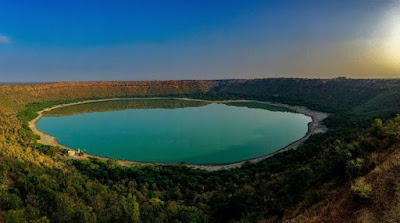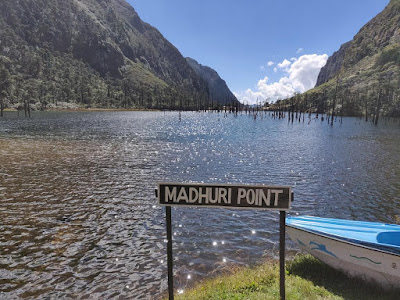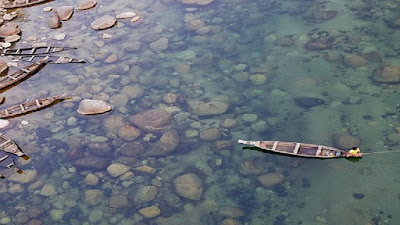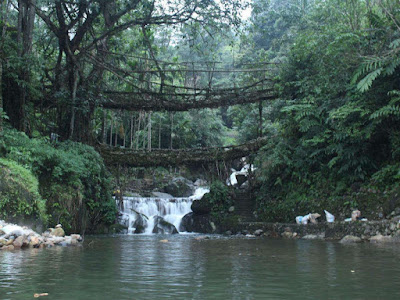10 Of The Most Incredible Natural Creations In India

When we think of natural wonders, the Grand Canyon, the Great Barrier Reef, Mount Everest and the Amazon Rainforest are the names that usually come into our mind. However, there also lies a treasure trove of gorgeously scenic natural wonders a little closer to home too.
INDIA, one of the World’s most variegated countries in terms of geographical diversity, has an amazing array of natural wonders. Well I know some of them are pretty well-known and doubtlessly spectacular, while others are less-discovered jewels. However, they have one thing in common-they will take away all your breath when you visit them after this pandemic is over.
Here’s a round up to revive your wanderlust!
1) Lonar Crater Lake, Maharashtra

Located right outside the Lonar town in Maharashtra, there's a lake which looks like the creation of something supernatural. Well, not an alien of course! The space was formed when a meteor crashed on Earth about 52,000 years ago. Considered as the World's third largest crater, the Lonar crater is the youngest and best preserved impact crater formed in basalt rock and is the only of its kind on earth.
One of the mysterious things about it is that the water in the lake is both saline and alkaline in nature and looks green in color when looked at from a certain distance. The circumference of the lake is said to be 8 km at the top, and 4.8 km at the bottom. One can find various mentions of this lake in ancient scripts like Skand Puran, the Padma Puran and Ain-i-Akbari.
To know more mysterious things about it and other similar places like it. You can read 7 Unknown & Most Mysterious Places In India To Visit.
2) St Mary's Island, Karnataka

Also known as Coconut Island or Thonsepar, St Mary’s Island lies off the coast of Malpe in Karnataka. What makes this island so special is its numerous volcanic rock formations. Known as the Columnar Basaltic Lava, this set of hexagonal and polygonal rocks were formed about 60 million years ago, during the formation of the Deccan Traps, when dense viscid basaltic lava cooled down and took various interesting shapes. The shapes are so distinct that these rocks actually look man-made.
Interesting fact: this pristine little island is believed to have been a halt for Vasco Da Gama during his journey to Kerala. In 1979, it was declared a national geological monument by the Geological Survey of India.
Interestingly, while one half of the island is dotted by these rock pillars, the other half is a shellfish haven, with all kinds of seashells and pebbles (broken shells smoothed by years of continuous wave action) carpeting the beach.
3) Belum Caves, Andhra Pradesh

Approximately 275 kms from Bangalore, in the Kurnool district of Andhra Pradesh, sit second largest and the longest caves on the plains of Indian subcontinent - the Belum Caves. These caves, which get their name from the Sanskrit word bilum (hole). A traveller is often left awestruck at the beauty of this place, which were formed due to constant flow of water on limestone deposits over millions of years, forming stalactites, stalagmites, siphons, sinkholes, and water galleries. With all that in knowledge, one wonders as to how ancient this place is, and the kind of secrets and memories it has had over the years. The fact is that only 1.5 km of the cave is open to the tourists for now.
You can read about other beautiful caves present in India like: Borra Caves situated in Andhra Pradesh, Krem Liat Prah Caves of Meghalaya which is also the longest cave in South Asia.
4) Loktak Lake, Manipur

The largest natural freshwater lake in northeastern India, Loktak Lake is home to unique ecosystems called ‘Phumdi’ (a Manipuri word meaning floating mats of soil, vegetation and organic matter). Resembling miniature islands, these phumdis are found in various forms, floating on the attractive freshwater lake that serves as a lifeline for the communities living around it.
What makes the Loktak Lake even more special is the Keibul Lamjao National Park located at the south western part of the lake. It is the World’s only floating national park and is home to the endangered Manipuri brow-antlered deer, Sangai. The biodiversity hotspot is also home to 233 species of aquatic plants, more than 100 species of birds, and 425 species of animals. What an unimaginable place man!
5) Barren Islands, Andaman and Nicobar Islands

Surrounded by nothing but water for miles, Barren Island of Andaman Sea provides glimpses of nature at its most primordial. Situated at the cross of the seismically active Indian and Burmese plates, the uninhabited island is 1.8 million years old and provides a place of rest for large marine creatures like turtles, manta rays and reef sharks on their migrations.
The sand on the island’s narrow beaches has a deep purple-black hue. At places where the shrub-covered slopes reach the sea, steam rises in swirling spirals as if reaching for the sky. A place where one can literally witness planet-building in action, a visit to Barren Island promises to be an electrifying experience.
6) Sangetsar Lake, Arunachal Pradesh

Formed as a result of an earthquake, Sangetsar Lake in Arunachal Pradesh is enchanting in its beauty. This name of high-altitude lake is actually pronounced as Sho-Nga-seir by locals, after the Shok-Tsen village that was transformed into a lake due to an earthquake in 1971. It is also known as Madhuri Lake, after the actress shot here for the movie Koyla, and is deeply admired by Buddhists in both India and Tibet.
Numerous dead tree trunks, which were once alive before the earthquake, emerge from the serene waters of the lake creating a hauntingly picturesque imagery before visitors.
Do note that a special permit from the District Commissioner’s (DC) office at Tawang (about 30 kms away) is required to visit this lake.
7) Mud Volcanoes, Andaman and Nicobar Islands

A very rare geological phenomena, mud volcanoes are formed by emission of depressurized pore water and natural gases from decaying organic matter underground, accompanied by loud explosions and fire flares. This gradually forms a miniature volcano with rich, creamy mud crater at the top.
As per available records, the first observed mud volcano explosion on Baratang island was observed in March 1983 in Nilambur village. Called as jalkis by the locals, these mud volcanoes have been occasionally erupting since then. In 2004-05, the mud volcano eruptions witnessed a spurt due to increased seismic activity in the region (associated with the 2004 Indian Ocean earthquake)
8) Umngot River, Meghalaya

A little-known gem, river Umngot flows through Dawki, a small town in Meghalaya’s East Jaintia Hills district that is a mere 95 km away from the capital Shillong. The site of a boat race held in March-April every year, the river is famous for the incredible clarity of its waters that makes it almost completely transparent.
Thus, one can clearly see both the river’s thriving aquatic life and its rock-strewn emerald-green river bed from the boats of the local fishermen (or the single-span suspension bridge hanging over the river). At some times, the water is so crystal clear that, when seen from a distance, it appears as if boats are floating in mid-air!
9) Gandikota Canyon, Andhra Pradesh

With striking resemblance to the USA's majestic Grand Canyon, Gandikota is a 300-feet-deep valley located in Cuddapah district of Andhra Pradesh. Believed to be more than a thousand years old, the canyon is also known for the 13th-century Gandikota Fort - an intricately-carved citadel made of red sandstone.
Few sights in India can beat Gandikota in instilling stunning awe. Peering over the edge of this giant hole in the ground is enough of a thrill for some, but to really appreciate the canyon’s greatness, one can hike all the way up to the top of the gorge for unforgettable views of the river Pennar flowing through the forested canyon.
10) Living Root Bridges, Meghalaya

One of the most well-known natural creations in India is these Living Root Bridges of Meghalaya. Centuries old living bridges over swift flowing streams provide a stable alternative to the easily destroyed wooden bridges in the feisty rainy season of Meghalaya’s Cherrapunji. Some well-known examples are the 180-year-old Nongriat double decker bridge, the Ritymmen Root Bridge (the longest at 30 m) and the Mawsaw Root Bridge (that has several natural swimming holes nearby).
Constructed by the native Khasi tribe, these bridges have been built by tangling the naturally growing roots of Ficus Elastica rubber trees (native to the region) through hollow betel nut tree (Areca Catechu) trunks to form a structure that grows stronger over the years. Once built, they don’t need maintenance, with thickening roots enhancing the solidity of the base and smaller vines growing into a protective railing.
Source: Google.com & thebetterindia
Suggestions are welcome, click here to contact me
Please Share and Subscribe for latest Blogs
Thank You for reading!









Comments
Post a Comment